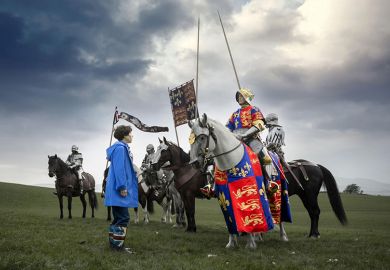A medieval literature expert hopes to shed light on themes such as "the history of trying to conceive", early pregnancy loss and fertility by using art to help the public engage with academic research.
That is the premise behind a new exhibition called Conceiving Histories – part of this year’s Being Human festival of the humanities in the UK – which features urine samples, uteruses suspended from the ceiling like hot air balloons and even an annunciation scene in which a woman learns she is pregnant from a frog.
Isabel Davis, reader in medieval literature and culture at Birkbeck, University of London, is researching the history of what she described as “unpregnancy”, meaning “questions of fertility and trying to conceive, and particularly the time before diagnosis either of pregnancy or infertility”. She has now acquired a vast range of material.
It is well known that Queen Mary I suffered two false pregnancies and twice emerged from the birthing room without a baby to present to the assembled court. More obscure are the strange fads of the 1790s, when women briefly wore padded stomachs to imitate pregnancy, and the tropical frogs used by the Family Planning Association in pregnancy testing right up until the 1960s.
Most bizarre of all was the proposal put forward by a physician called Robert Lyall in 1826. In response to a paternity case in the House of Lords, which hinged on the maximum length of human gestation, he was determined to settle the question once and for all. He therefore hatched a bizarre imaginary scheme for an Experimental Conception Hospital which would “contain separate rooms for 50 virgins, between the ages of 14 and 55, and for 50 unmarried women” whom men would impregnate to a strict timetable.
In a previous project on kneeling figures in the Middle Ages, Dr Davis worked with a visual artist and found the experience “very productive and interesting. I saw the potential to change the way I was thinking. I wanted to explore the astonishing visual aspects of the narratives I was uncovering. I wanted to show the stories. It’s difficult with writing just to point at something.”
She therefore put out a call for a collaborator in 2015 and found one in the artist Anna Burel, whose earlier work had explored themes of “anatomy and miscarriage”. Her new exhibition is inspired by her responses to some of the case studies Dr Davis presented to her. When she heard about Dr Lyall’s hospital, for example, she “saw the 100 women and started to design their uniforms – I was trying to inhabit these women”.
In the longer term, Dr Davis hoped to collaborate with Ms Burel on an illustrated book addressing similar themes. Given that “there isn’t a general history of trying to conceive” and that “people don’t discuss early pregnancy loss”, she believed the exhibition and book could both offer valuable new perspectives for women (or couples) struggling with issues of fertility and “bring something to contemporary debates about childlessness”.
The Being Human festival, led by the School of Advanced Study, University of London in partnership with the Arts and Humanities Research Council and the British Academy, is organising more than 300 events all around the UK (and beyond) from 17 to 25 November. The Conceiving Histories exhibition can be seen at the Peltz Gallery, Birkbeck School of Arts until 13 December.
Register to continue
Why register?
- Registration is free and only takes a moment
- Once registered, you can read 3 articles a month
- Sign up for our newsletter
Subscribe
Or subscribe for unlimited access to:
- Unlimited access to news, views, insights & reviews
- Digital editions
- Digital access to THE’s university and college rankings analysis
Already registered or a current subscriber?






